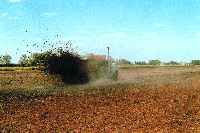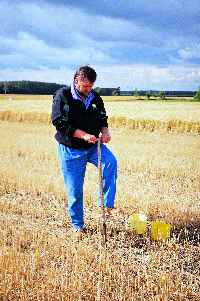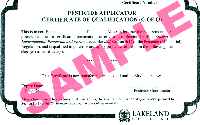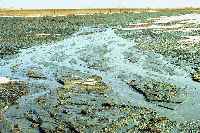| | Agricultural Operation Practices Act | Environmental Protection and Enhancement Act | Soil Conservation Act | Water Act | Public Health Act | Weed Control Act | Agricultural Pests Act
A number of Alberta and federal government acts relate to the potential environmental impacts of agricultural practices. This chapter provides an overview of the acts that are most relevant to crop production. Refer to the specific acts and regulations for detailed information. If your farm includes livestock, refer to the livestock manuals in the Beneficial Management Practices series for the acts relating to those operations.
Striving for excellence
The provincial and federal acts provide a foundation to ensure that agriculture is operating in a sound and responsible manner. Your operation must meet the legal requirements described in the acts and regulations. This manual is aimed at producers who are striving for excellence in environmental stewardship. Therefore, many of the practices described in Chapters 3 to 7 go beyond the basic legal requirements to help you reach your goals for an environmentally and economically successful operation.
Legal Requirements - The information in this chapter is provided for general information only. It is not intended as legal advice. Refer to the acts and regulations and consult a lawyer for legal advice on your specific legal rights and requirements.
More information on the environmental requirements under these acts can be obtained from Alberta's Natural Resources Conservation Board (NRCB), Alberta Agriculture and Rural Development, Alberta Environment, Environment Canada, consultants and lawyers.
Copies of Alberta's acts and regulations are available online or through the mail from the Queen's Printer (phone: 1-780-427-4952 (dial 310-0000 for a toll-free call).
Agricultural Operation Practices Act
A major component of Alberta's Agricultural Operation Practices Act (AOPA) is a set of environmental standards for nutrient management practices. All agricultural operations must comply by the end of 2004 with the legislation's manure management requirements to prevent water contamination and protect the soil.
Manure application
Manure can be applied only to arable land. Surface-applied manure must be incorporated into the soil within 48 hours, unless it is applied to forage or direct seeded crops. When applying manure, producers need to take into account setback distances from water bodies, slope, soil type, and the amount of nitrate and salt in the soil.

Surface-applied manure must be incorporated into the soil within 48 hours.
Courtesy of ARD
Setback requirements for injected and incorporated manure
When applying manure, the following setback distances from common bodies of water must be met (from AOPA Standards and Administration Regulation, Section 24):
- If the operator is directly injecting manure into the soil, injection must not occur within 10 m of a common body of water.
- If the operator is applying the manure to the soil surface and incorporating it within 48 hours, manure must not be applied within 30 m of a common body of water.
- An operator must not apply manure within 30 m of a water well.
Common Bodies of Water - Under AOPA, common bodies of water include: the bed and shore of an irrigation canal, drainage canal, reservoir, river, stream, creek, lake, marsh, slough or other exposed body of water. (See AOPA Standards and Administration Regulation Section 1 for exceptions.)
Setback requirements for surface-applied manure that is not incorporated
Operators who surface-apply manure on forage, direct seeded crops, and frozen and/or snow-covered soils must meet more stringent setback requirements, shown in Table 9.1. If it is possible that contamination may occur, the operator should increase the setback distance.
Table 9.1. Minimum setback distances for surface-applied manure on forage, direct seeded crops, and frozen and/or snow-covered soil*
| Average Slope** | Required Setback Distances from Common Body of Water |
| Less than 4% | 30 m |
| Greater than 4% but less than 6% | 60 m |
| Greater than 6% but less than 12% | 90 m |
| More than 12% | No application allowed |
* AOPA Standards and Administration Regulation, Schedule 3, Tables 1 and 2
** Slope, expressed as a per cent is calculated as the (rise/run) x 100.
Source: Alberta Agriculture and Rural Development. 2002. Reference Guide: Agricultural Operation Practices Act. Alberta Agriculture and Rural Development.
Salt and nitrate loading limitations
Unless you have an NRCB-approved nutriet management plan, you must not apply manure, composting material or compost to soil if:
- soil salinity is more than 4 deciSiemens per metre (dS/m) as measured by electrical conductivity using saturated paste extract analysis, based on a representative soil sample from the top 15 cm of soil. (AOPA Standards and Administration Regulation, Section 25)
- soil salinity will increase after manure is applied by more than 1 dS/m (same analysis method). (AOPA Standards and Administration Regulation, Section 25)
- soil nitrate-nitrogen levels in the top 60 cm will increase after manure is applied to a level that equals or exceeds the limits shown in Table 9.2.
You may apply above these levels if you can prove it will be beneficial to the soil.
Table 9.2. Nitrate-nitrogen limits for manure-applied lands in Alberta*
| Soil | Sandy Soils (> 45% Sand and Water Table Shallower than 4 M) | Sandy Soils (> 45% Sand and Water Table Deeper than 4 M) | Medium and Fine-Textured Soils |
| Brown | 80 kg/ha (75 lb/ac) | 110 kg/ha (100 lb/ac) | 140 kg/ha (125 lb/ac) |
| Dark Brown | 110 kg/ha (100 lb/ac) | 140 kg/ha (125 lb/ac) | 170 kg/ha (150 lb/ac) |
| Black | 140 kg/ha (125 lb/ac) | 170 kg/ha (150 lb/ac) | 225 kg/ha (200 lb/ac) |
| Gray Wooded | 110 kg/ha (100 lb/ac) | 140 kg/ha (125 lb/ac) | 170 kg/ha (150 lb/ac) |
| Irrigated | 180 kg/ha (160 lb/ac) | 225 kg/ha (200 lb/ac) | 270 kg/ha (240 lb/ac) |
* AOPA Standards and Administration Regulation, Schedule 3, Table 3.
Source: Alberta Agriculture and Rural Development. 2002. Reference Guide: Agricultural Operation Practices Act. Alberta Agriculture and Rural Development.
Soil testing
Operators who apply over 500 tonnes of manure (wet weight) annually are required to perform soil tests and maintain nutrient management records. Soil testing must be conducted to ensure that nitrate-nitrogen limits are not exceeded. Testing must be done by a qualified lab in accordance with the most recent edition of the Canadian Society of Soil Science's Manual on Soil Sampling and Methods of Analysis (AOPA Standards and Administration Regulation, Schedule 3).

People applying over 500 tonnes of manure annually must perform soil tests, but soil tests are a valuable tool for any crop producer.
Courtesy of ARD
Producers must regularly test for key soil characteristics on all manure-applied fields as follows (AOPA Standards and Administration Regulation, Schedule 3):
Record keeping
An owner or operator is required to keep nutrient management records for as long as that person owns the operation. All others receiving manure are required to keep records for five years (AOPA Standards and Administration Regulation, Section 28).
The requirements for record keeping depend on the amount of manure involved:
- A person who receives or removes 500 tonnes or more of manure per year must record:
- the volume or weight of manure received or removed;
- the name and address of the person from whom manure is received or removed; and
- the date of the receipt or removal.
- A person who applies 500 tonnes or more of manure per year to land under the person's control must record:
- the name and address of a person from whom manure is received, the date it was received, and the volume or weight received;
- the legal description(s) of the field(s) receiving manure and the area of land to which manure is applied;
- the volume or weight of the manure applied to each field;
- the application rates of manure nutrients and fertilizer by field and year;
- the dates of application and incorporation for each field and the method used; and
- the soil test results by field for the nutrients specified in Schedule 3 (AOPA Standards and Administration Regulation).

AOPA specifies the types of records to be kept by people spreading manure.
Courtesy of ARD
- For information on the regulations pertaining livestock operations and manure storage, refer to the livestock manuals in this Beneficial Management Practices series or contact the nearest NRCB office.
Environmental Protection and Enhancement Act
Pesticide use
The EPEA regulates the sale, use, application, handling, storage, transport and disposal of pesticides. For example, the regulations of this Act specify:
- Use of pesticides according to the directions specified on the label.
- Transportation and disposal of pesticides in a way that ensures they will not contaminate food or water.
- Storage of pesticides in their original containers or in other containers that are clearly marked.
- Responsibility of the user for cleanup and decontamination in case of accidental spills.
- Washing of pesticide-contaminated material or sprayers is prohibited within 30 m of an open water body or on a public waterworks system.
- Pesticide storage is not allowed within 30 m of an open water body.
- No person shall use, apply handle, transport, store or dispose of a pesticide or operate any equipment involving the use, handling, transportation, storage handling or disposal of pesticides in a manner that is or is likely to cause an adverse effect.
There are also restrictions on the handling of pesticide application equipment. These include:
- The operator must be present at all times while filling the sprayer, and must maintain an air gap or have an operating back flow prevention device while filling the sprayer tank from a municipal waterworks system or from an open body of water.
- A Pesticide Applicator Certificate and Service Registration is required for commercial applicators.
- A Special Use Approval permit is required from Alberta Environment to apply or store pesticides or wash equipment used to apply pesticides in, on or within 30 m of an open body of water. This does not include sloughs or ponds less than 10 acres in area, providing they are completely surrounded by private land with no drainage off the land.
- Some pesticides have unique hazard characteristics and require the applicator to be knowledgeable to use them. Therefore producers must become certified to purchase and apply certain hazardous pesticides. This mandatory certification currently applies to: aluminium phosphide (Phostoxin, Gastoxin); picloram (Tordon 22 K); and triclopyr (Garlon).

Commercial pesticide applicators must be certified.
Source: Lakeland College
Pesticide applicator training courses are available at Fairview College (1-780-835-6617 or (1-888-999-7882), Lakeland College (1-866-853-8646), Olds College (1-800-661-6537 or 1-403-556-4684) and Lethbridge Community College (1-800-572-0103 or 1-403-320-3323).
Prohibited releases
The Environmental Protection and Enhancement Act (EPEA) prohibits operators from releasing into the environment a substance in an amount, concentration or level or at a rate of release that causes or may cause a significant adverse effect on the environment. While "significant" is not defined in EPEA, "adverse effect" is broadly defined to mean the "impairment of, or damage to, the environment, human health or safety or property." For example, if a farm operator spreads manure on land at a rate that will overload the nutrient levels in the soil, or releases manure on land where the manure will run into a water body, the operator is in violation of EPEA.
Alberta Environment can issue a substance release environmental protection order (EPO) when a substance release into the environment is causing, has caused or may cause an adverse effect. These EPOs can be issued even if an operation is in compliance with legislation, as they are intended to be remedial/preventive in nature rather than punitive. Generally these EPOs will direct an operator to develop a plan for dealing with the release and to implement the plan once it has been approved by Alberta Environment.
Alberta Environment can also issue an EPO to an individual responsible for the release of an offensive odour, to order that individual to, among other things, prevent, minimize or remedy the offensive odour or destroy the cause of the odour. This power does not apply to offensive odours from an agricultural operation that is carried on in accordance with "generally accepted practices" for that operation. However, there is no definition of "generally accepted practices." Whether an operator is following "generally accepted practices" will be decided by the Environmental Appeal Board or by a peer review board appointed by the Minister of Agriculture, Food and Rural Development.
Duty to report
EPEA requires operators to report any releases that may cause an adverse effect on the environment. A release must be reported immediately once it has been discovered. Failure to report a release can result in significant fines. Calling Alberta Environment's emergency response line (1-800-222-6514) is usually sufficient to report a release. In some circumstances, an operator will also be required to file a subsequent written report.
Typically, when an operator reports a release, Alberta Environment will require the operator to identify the steps that the operator is taking to prevent harm to the environment and to prevent the release from reoccurring.
Liability of directors and officers
If a corporation violates EPEA, any officer, director or agent of the corporation who was involved with the incident, even in a minor way, could face prosecution under EPEA. This applies whether or not the corporation itself is prosecuted for the violation and regardless of whether the officer, director or agent works for a large corporation or simply a small incorporated family farm. This means an officer, director or agent of an incorporated farm is held personally responsible for EPEA violations, if the officer, director or agent directed or participated in the violation in any way.
Intent to commit
The vast majority of offences under EPEA are "strict liability" offences. Unlike criminal offences, with strict liability offences, the courts are only concerned with whether the operator committed the offence, and not whether he or she intended to commit the offence or the morality of the operator's actions. If the operator did cause the impairment, the courts will convict the operator unless the operator can show that the action was in accordance with due diligence in running the operation and in carrying out the activity at issue (see Section 9.3 for more on due diligence). That is, if the operator can show that all reasonable steps were taken to prevent the contravention of EPEA, the operator will not be found guilty under EPEA.
For a small proportion of the offences under EPEA, the intent to commit the offence must also be proven to obtain a conviction. For those offences, the due diligence defence does not apply.
Fines
For strict liability offences, an individual is liable for a fine of not more than $50,000 for each offence under EPEA and a corporation is liable for a fine of not more than $500,000 for each offence under EPEA. Each day that a release or impairment occurs is treated as a separate offence. For example, a release from a catch basin occurring over two days would be treated as two offences and expose the corporation to a maximum fine of $1 million.
Those offences that require proof of intent to commit the offence carry higher penalties: a $100,000 maximum fine for individuals and a $1 million maximum fine for corporations.
Soil Conservation Act
The Soil Conservation Act gives municipal councils the authority to protect land from soil loss or deterioration. Under the Act, each landholder has the responsibility to actively prevent soil loss or deterioration from taking place or, if soil loss or deterioration is already taking place, to stop it from continuing. Each municipal council has the duty to ensure that each landholder in its jurisdiction fulfils this responsibility.
When agricultural practices cause or are likely to cause soil degradation, a soil conservation officer, usually an agricultural fieldman acting on behalf of the municipality's agricultural services board, may serve notice on the landholder advising him or her to take remedial action within a specified time. The landholder may appeal this notice. If the appeal fails, then the landholder must comply with the notice.

Landholders are required to actively prevent soil degradation.
Courtesy of ARD
If the remedial action is not done within the specified time, the soil conservation officer and/or others under the officer's direction may enter the property and perform the required work. The cost of this work may be collected by a tax on the property. Any person obstructing the officer or failing to comply with the notice is subject to a fine of up to $5,000.
Water Act
The Water Act became law in January 1999. Approval from Alberta Environment is required for the undertaking of an activity that may:
- alter the flow or level of water,
- change the location or direction of flow of water,
- cause siltation of water,
- cause erosion of any bed or shore of a body of water, or
- cause an effect on the aquatic environment.
To find out if your planned project requires a licence, contact a water specialist at Alberta Agriculture and Rural Development or Agriculture and Agri-Food Canada - PFRA.
Public Health Act
The Public Health Act gives regional health authorities significant powers to protect the public health. This Act has priority over all provincial statutes, except the Alberta Bill of Rights.
The Public Health Act allows a regional health authority, if it has reasonable and probable grounds to believe that a nuisance exists, to enter onto property to inspect the property, take samples of any substance or equipment being used, and perform tests at the property. The Act defines "nuisance" as: "a condition that is or that might become injurious or dangerous to the public health, or that might hinder in any manner the prevention or suppression of disease."
Thus, if a regional health authority becomes aware of a public health hazard at a farm, it can take steps to protect the public health and have the health hazard eliminated. In addition, if a farm operator contravenes the health authority's orders, the operator is liable to a fine of not more than $100 for each day the contravention continues.
Weed Control Act
The Weed Control Act provides the legal authority to enforce weed control. It identifies three categories of weeds: restricted, noxious and nuisance. It mandates the eradication of restricted weeds and control of noxious and nuisance weeds.
Agricultural Pests Act
The Agricultural Pests Act is enabling legislation that provides the legal authority to deal with native and introduced pests (insects, vertebrate pests and plant diseases) that affect agricultural production.
Back to Chapter 9 - Legislation |
|